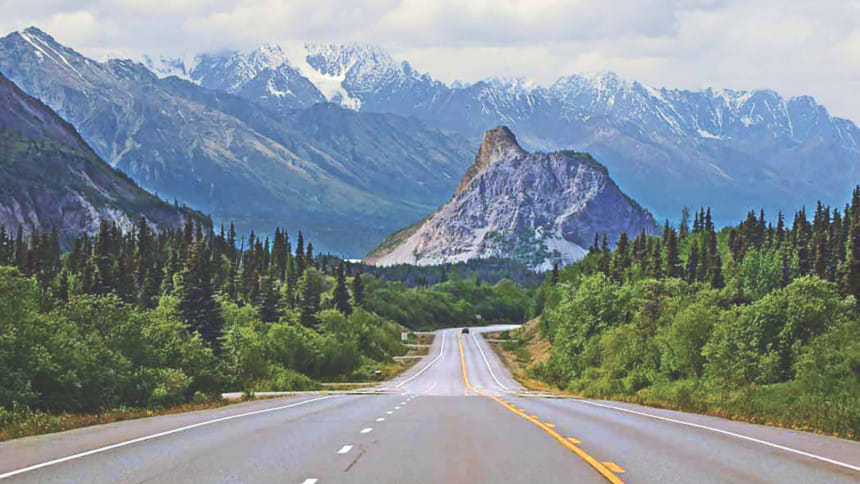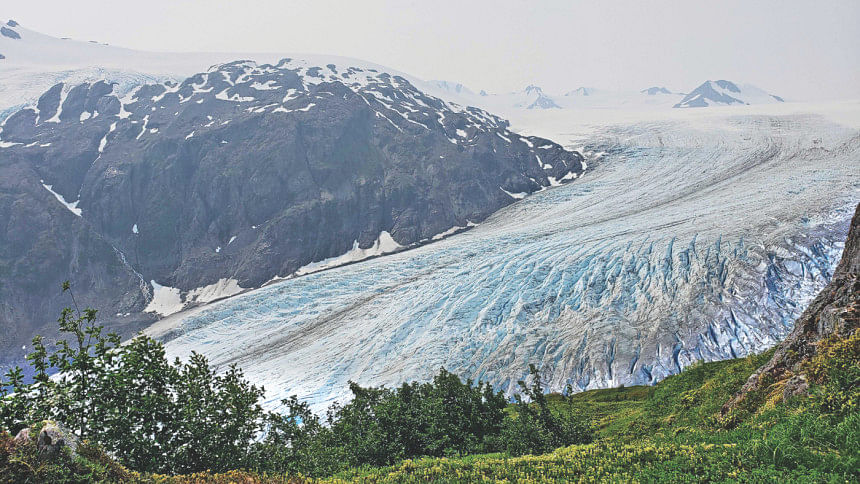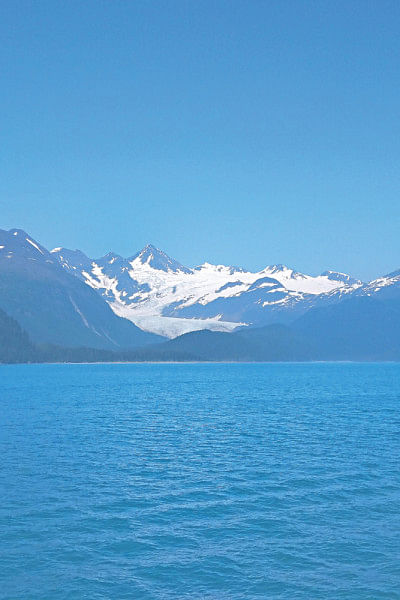Days and nights under the midnight sun

Known for its overwhelming natural beauty and incredible ice formations, Alaska, the largest state (in area) of the United States is home to a multitude of geological wonders. The state boasts 100,000 plus glaciers, 17 of the 20 highest mountains in the country, scores of active volcanoes, seven national parks, unsullied wilderness, plentiful wildlife, and a diverse ecosystem. With so many fascinating options to explore, a select few—Denali Wilderness, Tidewater Glaciers and Kenai Peninsula, were among the must-see attractions during our short visit to the state in July 2019.
Denali Wilderness National Park is a parcel of untrammeled, pristine, primeval land in its rawest form that is unmatched in size and beauty. The wilderness spans over six million acres, enclosing and protecting one of the world's last great frontiers. Landslides, glacially-fed braided rivers, and moving glaciers define the ever-changing landscape of the wilderness, from boreal forests dense with rising pines, birch, and aspen, to barren tundra dotted with jagged mountains chiseled by glaciers. Near the entrance to the park, long, steep, rocky cliffs line a canyon while the Nenana River twists and turns violently below.
In the park, one can go only so far—or rather, so near, by car. The only road inside the park is the Denali Park Road, which runs parallel to the Alaska Mountain Range. Meandering through low valleys and high mountain passes, the road is unpaved, rugged, narrow, and winding. There are many areas with hairpin curves and steep drop offs with no guardrails. That is why private vehicles can only drive to Savage Creek, about 15 miles from the entrance. To see the park past there requires a bus tour.
We took the 13-hour Tundra Wilderness Tour on July 4, 2019, travelling 95 miles in each direction to the Denali Backcountry Lodge in Kantishna. It is a remote settlement with a fascinating gold rush history and surrounded by the best of Denali.
We stopped at several scenic spots—Sanctuary River, Igloo Creek, Polychrome Mountain, Toklat River, Wonder Lake, and Eielson Visitor Center. From the vista points and from the bus, we had a sweeping view of Denali's north flank, as well as other mountains in the Alaska Range that straddles the park.
We experienced everything the wilderness has to offer: forests and marshy lowlands giving way to hills, and subarctic tundra. The towering granite spires, their snowy summits, eye-catching glaciers and glacial valleys running southwards enthralled us. At every turn, we saw landscapes full of surprises, and the further we traveled, the more it revealed. During our visit, the famous—often notorious—clouds in the park took a break to reveal the great massif of Mount Denali itself, 20,320 feet high roof of North America.
More than 650 species of flowering plants, shrubs, lichen and moss comprise the vegetation of the park. It is amazing how a land that can be so harsh and desolate with long, bitterly cold winters is the biome for so many beautiful flowers and plants.

One of the wild flowers that caught our attention is fireweed. We saw this gorgeous native flower enflamed in shocking pink shooting up not only in Denali, but also in all the places we visited in Alaska. The ubiquity of fireweed has spread to store shelves, where we found it made into honey, jelly, syrup, tea, and even ice cream.
Denali's wildlife encompasses a variety of species. Grizzlies, black bears, moose, caribous and curve-horned Dall sheep pace the grounds, among others, while falcons, hawks, and golden eagles claim the skies. Black bears inhabit the forested areas of the park, while grizzly bears mainly live on the open tundra.
We saw grizzlies with cubs, including a stray cub eating berries near the road, a herd of Dall sheep and moose roaming freely in their natural habitat. Grizzlies and sheep were spotted way up in the mountains, but luckily, we had two powerful binoculars with us. We saw several caribous with impressive antlers sitting in open areas near the Eielson Visitor Center. We also saw marmots, arctic ground squirrels, and snowshoe hares at the ground level, and several species of birds including a golden eagle perched atop a mountain.
The tour of Denali Wilderness was a wonderful experience for us, especially since it coincided almost exactly with the summer solstice when there is no clear division between day and night. The nearly continuous sunlight debunked assumptions we make about the separation of night and day and how that separation affects animal behavior, including our own.
Next on our bucket list was Tidewater Glaciers, which are valley glaciers that flow far enough to calve into the water. The best place to see these glaciers is from the protected waters of Prince William Sound, which was in the news in 1989 when the oil tanker Exxon Valdez spilled 11 million gallons of crude oil. The Sound had been a pristine wilderness before the spill. The disaster dramatically changed all of that, taking a major toll on wildlife. Today, it appears to have recovered, though not completely.
Our itinerary included a ferry ride on the Sound—from Valdez to Cordova. Accordingly, on July 5, 2019, we departed for Valdez from Healy, a backwood small town located close to the Arctic Circle, where we had the unique opportunity to experience 24 hours of sunlight. We drove south to Wasilla, got on the eastbound Glenn Highway and then took the southbound Richardson Highway at Glennallen all the way to Valdez.
Driving on the Glenn Highway was like driving through Alaska's postcards. We saw one scene after another along this road that one sees in promotional photos and guidebooks. There were multiple turnouts with nice viewpoints. We stopped to see a massive glacier, the Matanuska Glacier, from a close range. We also had a breathtaking view of the Wrangell Mountains with elevations varying between 12,000 feet (Mount Drum) and 16,400 feet (Mount Blackburn). At 14,160 feet, Wrangell Mountain in the chain is the largest active volcano in Alaska.

After nearly eight hours of leisurely driving, we reached Valdez at seven in the evening. When driving into Valdez, we passed through Keystone Canyon, which is the site of two captivating waterfalls—The Horsetail and Bridal Veil towering over the canyon walls, greeting travellers from above.
Situated in a majestic fjord, Valdez is often called Alaska's "Little Switzerland" because it is ringed by the tall, snowcapped Chugach Mountains rising from the Prince William Sound. Unfortunately, we did not have enough time to explore the dramatic natural setting of Valdez. However, we stopped by a lake at the terminus of Valdez Glacier to see icebergs, plenty of them. It was a nice place to get an unimpeded view of the Chugach Mountains and their reflection in the lake.
We left for Cordova on July 6, 2019 on a ferry of the Alaska Marine Highway System. It was a 13-hour cruise on the Prince William Sound, which is full of precipitous fjords and sheer-sided coastal mountains. There are over 100 tidewater glaciers inching their way through mountain valleys into the waters of the Sound. The most prominent glacier is the Columbia Glacier, one of the largest and most imposing glaciers in Alaska. Although we got a distant view of Columbia Glacier, nevertheless we saw other glaciers, dropping steeply as cliffs of ice from the mountains that tower above the coast.
Calving and some melting is a normal process that glaciers undergo during seasonal transitions from winter to summer. Global warming accelerated their melting across the surface. Consequently, there were many mountains without glaciers.
As the ferry coasted ever so slowly through the calm waters of the Sound dotted with emerald-hued islands, we saw cascading waterfalls, variety of birds and marine animals, but no whales. We also saw a few small icebergs floating around, but not too close to the ferry.
The ferry docked at Cordova just before midnight when the Sun was still shining brightly in the sky. Situated on the Orca Inlet, Cordova is a fishing community with an old-fashioned downtown and excellent view of Chugach Mountains. People of Cordova are so much into fishing, it is often said that they move with the rhythms of wild salmon.
Our next destination was Seward in the Kenai Peninsula. The easiest route to Seward is to take the ferry to Whittier and then drive 90 miles on a scenic highway. Since there was no ferry service until July 8, 2019, we had an extra day to unwind and undertake a less strenuous activity at Cordova.
Out of a plethora of activities to do on land and water, we did the Orca Inlet Adventure by a small, motorised boat. The panoramic six-hour cruise on the inlet allowed us to see the highest concentration of sea otters in the world.
Even though we spent only a day at Cordova, we found the stunning snowcapped peaks, dense rainforests, riveting Copper River Delta, not to mention the town's handful of historic, shuttered, mossy buildings screaming to serve as the backdrop for a Stephen King novel.
We reached Seward in the early afternoon hour of July 8, 2019. Sandwiched between Resurrection Bay and the Kenai Mountains, Seward is a tiny seaside resort, with a bustling harbor, quaint shops, cafes, seafood restaurants and art galleries, and an abundant offering of Alaskan adventures into the surrounding marine and mountain environments. It is also the gateway to Kenai Fjords National Park, one of the major attractions in the peninsula where ice age lingers.
Knowing that July is peak tourist season in Alaska, we booked the Northwestern Fjord Full-Day narrated cruise as early as February 2019. But our children had a big surprise for us. The night before, they told us that they cancelled the fjords tour and instead made reservation for a two-day cruise on the Resurrection Bay on a small yacht for me and my wife. As for themselves, they would stay in Seward to do zip line and hike to the Harding Ice field, which is considered a window to past ice ages. It feeds more than 30 glaciers that reach out from it, flowing down through the mountains like great tentacles. The children later told us that the hike was extremely strenuous, gaining approximately 1,000 feet of elevation with every mile of the 9-mile round trip.
We had no regrets for the cancellation of the fjords tour that promises real close encounter with tidewater glaciers. By now, we have seen hundreds of glaciers and even walked on one of them in the Denali Mountains. Hence, we considered the yacht cruise a welcome diversion and thanked the children for their thoughtfulness.
After a quick bite, we parted company and boarded the yacht named Gambler. The captain was a 25-year old anthropology major, and the deck hand was her father, a retired high school teacher who had taught in Myanmar for two years. A well-travelled man, we found him very knowledgeable about the neighbouring countries, including Bangladesh.
Known as the "gateway to the Kenai Fjords," Resurrection Bay is considered the largest fjord along the coast of the Kenai Peninsula. A giant glacier bridging the Harding Ice field to the west with the Sargent Ice Field to the east formed it. The striking panorama of the bay is the result of the glacier's grinding action during its advance and retreat.
The bay houses many marine life including sea lions, seals, and sea otters. Depending upon time of the year and a host of other factors, Orca and Humpback whales migrate to these waters.
The first day on the yacht was more of a mellow pleasure cruise than an expedition into the heart of Resurrection Bay. As the yacht sailed through the glacier laced mountains, we saw many puffins, murres, cormorants, and sea gulls. Before long, we arrived at Humpy Cove, where the yacht was anchored for the night. The rocky shores of the cove are surrounded by mountains thrust into the low clouds. The cove has a backdrop of two small waterfalls and is loaded with Humpback Salmon.
Next morning, we sailed farther out into the bay. An hour into the cruise, the deck hand pointed out some sea lions basking on boulders on the shore. Unfortunately, we did not spot any whales during the cruise.
We stopped at the Orca Island Cabins, a resort on a private island with yurt (Mongolian tent) accommodations, giving the impression that they are somehow clinging to the cliffs. The night was spent at Thumb Cove, a wonderfully scenic spot surrounded by huge peaks with alpine glaciers hanging to their flanks.
The isolation of the coves and sailing on the bay among a setting of alpine glaciers, waterfall-laced cliffs and blue-green water made the cruise a memorable one. As the locals say, Resurrection Bay resurrects your soul. Indeed, it resurrected ours.
We came back to Seward in the late morning hour of July 10, 2019 and left for our next destination, Homer, in the afternoon. There is only one road leading into Homer—the Sterling Highway. This end-of-the-road town is known as the "Halibut Fishing Capital of Alaska." An eclectic mix of artists, fishermen and outdoor lovers make up the lifeblood of Homer.
Homer is famous for its geographical landmark—"The Spit," so called because it is the remains of an ancient glacial moraine. It is a long, narrow finger of land jutting into the Kachemak Bay. There is a little downtown in the middle of the Spit with many cafes, restaurants, and gift shops. We spent the entire evening strolling on the boardwalk in the Spit and driving through the town, stopping at vista points to look at the scenery and glaciers in the surrounding mountains.
Our Alaska vacation concluded on July 11, 2019 with an afternoon drive to Anchorage to catch the overnight flight to Newark. Was the vacation worth the time and expense? Alaska is so vast and so magnificent in its varied geography that a typical ten-day trip just was not enough to take it all in. That is because Alaska has it all, from untamed wilderness with an abundance of wildlife to lofty mountains to volcanoes to spectacular glaciers. After touring Alaska, I realised how insignificant we are in the grand scheme of things.
Quamrul Haider is a professor of physics at Fordham University, New York.

 For all latest news, follow The Daily Star's Google News channel.
For all latest news, follow The Daily Star's Google News channel. 



Comments